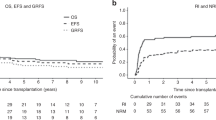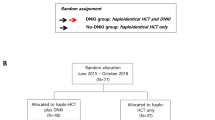Abstract
Advanced haematological malignancies are incurable without allogeneic haematopoietic SCT (HSCT). Many patients do not have a human leukocyte Ag (HLA)-matched donor; hence, haploidentical HSCT has been explored for some 20 years. Previous poor outcomes have improved recently with modifications, including the use of killer Ig-like receptor (KIR)-ligand-mismatched donors and highly T-cell-depleted megadose CD34+ stem cell infusions. Haploidentical HSCT was undertaken in 10 patients with heavily pretreated and advanced myeloid malignancies. Patient/donor pairs were KIR-ligand mismatched (GVL direction). Conditioning regimen was ATG, melphalan, fludarabine and thiotepa. G-CSF-mobilized PBSCs were CD34+ cell selected. No post transplant immunosuppression was given. Two patients died early; all others had sustained engraftment. Natural killer cell recovery, often to supranormal levels, occurred early, whereas CD4+ T-cell recovery was delayed. Acute GVHD occurred in three of eight (30%) patients, and chronic GVHD occurred in three of six (50%) evaluable patients. No infections with Candida or Aspergillus developed in seven patients receiving caspofungin prophylaxis. Three of 10 (30%) patients were alive and disease free at 10.1, 6 and 5.4 years post transplant (Karnovsky scores of 100%). In this heavily pretreated cohort with very advanced myeloid malignancies, KIR-ligand-mismatched haploidentical HSCT cured a significant proportion of patients.
This is a preview of subscription content, access via your institution
Access options
Subscribe to this journal
Receive 12 print issues and online access
$259.00 per year
only $21.58 per issue
Buy this article
- Purchase on Springer Link
- Instant access to full article PDF
Prices may be subject to local taxes which are calculated during checkout




Similar content being viewed by others
References
Beatty PG, Mori M, Milford EL . Impact of racial genetic polymorphism on the probability of finding an HLA-matched donor. Transplantation 1995; 60: 778–783.
Rocha V, Labopin M, Sanz G, Arcese W, Schwerdtfeger R, Bosi A et al. Transplants of umbilical cord blood or bone marrow from unrelated donors in adult with leukemia. N Engl J Med 2004; 351: 2276–2285.
Laughlin MJ, Eapen M, Rubinstein P, Wagner JE, Zhang MJ, Champlin RE et al. Outcomes after transplantation of cord blood or bone marrow from unrelated donors in adults with leukemia. N Engl J Med 2004; 351: 2265–2275.
Henslee-Downey PJ, Abhyankar SH, Parrish RS, Pati AR, Godder KT, Neglia WJ et al. Use of partially mismatched related donors extends access to allogeneic marrow transplant. Blood 1987; 89: 3864–3872.
Aversa F, Tabilio A, Terenzi A, Velardi A, Falzetti F, Giannoni C et al. Successful engraftment of T-cell-depleted haploidentical ‘three-loci’ incompatible transplants in leukemia patients by addition of recombinant human granulocyte colony-stimulating factor-mobilized peripheral blood progenitor cells to bone marrow inoculum. Blood 1994; 84: 3948–3955.
Guinan EC, Boussiotis VA, Neuberg D, Brennan LL, Hirano N, Nadler et al. Transplantation of anergic histoincompatible bone marrow allografts. N Engl J Med 1999; 340: 1704–1714.
Anasetti C, Beatty PG, Storb R, Martin PJ, Mori M, Sanders JE et al. Effect of HLA incompatibility on graft-versus-host disease, relapse, and survival after marrow transplantation for patients with leukemia or lymphoma. Hum Immunol 1990; 29: 79–91.
Kernan NA, Flomenberg N, Dupont B, O’Reilly RJ . Graft rejection in recipients of T cell depleted HLA-nonidentical marrow transplants for leukemia: identification of host derived anti-donor allocytotoxic T lymphocytes. Transplantation 1987; 43: 482–487.
Aversa F, Tabilio A, Velardi A, Terenzi A, Falzetti F, Carotti A et al. Hematopoietic stem cell transplantation from alternative donors for high-risk acute leukemia: the haploidentical option. Curr Stem Cell Res Ther 2007; 2: 105–112.
Reisner Y, Martelli MF . Bone marrow transplantation across HLA barriers by increasing the number of transplanted cells. Immunol Today 1995; 16: 437–440.
Ruggeri L, Capanni M, Urbani E, Perruccio K, Shlomchik WD, Tosti A et al. Effectiveness of donor natural killer cell alloreactivity in mismatched hematopoietic transplants. Science 2002; 295: 2097–2100.
Ruggeri L, Mancusi A, Capanni M, Urbani E, Carotti A, Aloisi T et al. Donor natural killer cell allorecognition of missing self in haploidentical hematopoietic transplantation for acute myeloid leukemia: challenging its predictive value. Blood 2007; 110: 433–440.
Ruggeri L, Capanni M, Casucci M, Volpi I, Tosti A, Perruccio K et al. Role of natural killer cell alloreactivity in HLA-mismatched hematopoietic stem cell transplants. Blood 1999; 94: 333–359.
Walker IR . Meeting report. Workshop on haploidentical stem cell transplantation: Chicago, Illinois, USA, 18–19 November 2000. Leukemia 2002; 16: 424–426.
Delfino L, Morabito A, Pera C, Ferrara GB . Sequence-based typing for HLA-C. Medium Size PCR Protocol. Chapter 9-A. In: Tilanus MGJ, Hansen JH, Hurley CK (eds). IHWG Technical Manual. Genomic Analysis of the Human MHC: DNA-Based Typing for HLA Alleles and Linked Polymorphisms 2000: Publication of the 13th International Histocompatibility Working Group. Fred Hutchinson Cancer Research Center: Seattle, WA, ISBN:0-945278-02-0.
Volpi I, Perruccio K, Tosti A, Capanni M, Ruggeri L, Posati S et al. Postgrafting administration of granulocyte colony-stimulating factor impairs functional immune recovery in recipients of human leukocyte antigen haplotype-mismatched hematopoietic transplants. Blood 2001; 97: 2514–2521.
Prezpiorka D, Martin P, Klingmann HG, Beatty P, Hows J, Thomas ED . 1994 Consensus Conference on acute GVHD grading. Bone Marrow Transplant 1995; 15: 825–828.
Sullivan KM, Agura E, Anasetti C, Appelbaum F, Badger C, Bearman S et al. Chronic graft-versus-host disease and other late complications of bone marrow transplantation. Semin Hematol 1991; 28: 250–259.
Kaplan L, Meier P . Non-parametric estimation for incomplete observations. Am Stat Assoc 1958; 53: 457–481.
Ciurea SO, Saliba R, Rondon G, Pesoa S, Cano P, Fernandez-Vina M et al. Reduced-intensity conditioning using fludarabine, melphalan and thiotepa for adult patients undergoing haploidentical SCT. Bone Marrow Transplant 2009; 45: 429–436.
Fuchs EJ, Huang X-J, Miller JS . HLA-haploidentical stem cell transplantation for hematologic malignancies. Biol Blood Bone Marrow Transplant 2009; 16 (Suppl): S57–S63.
Ciceri F, Labopin M, Aversa F, Rowe JM, Bunjes D, Lewalle P et al. A survey of fully haploidentical hematopoietic stem cell transplantation in adults with high-risk acute leukemia: a risk factor analysis of outcomes for patients in remission at transplantation. Blood 2008; 112: 3574–3581.
Perruccio K, Tosti A, Burchielli E, Topini F, Ruggeri L, Carotti A et al. Transferring functional immune responses to pathogens after haploidentical hematopoietic transplantation. Blood 2005; 106: 4397–4406.
Leen AM, Christin A, Myers GD, Liu H, Cruz CR, Hanley PJ et al. Cytotoxic T lymphocyte therapy with donor T cells prevents and treats adenovirus and Epstein–Barr virus infections after haploidentical and matched unrelated stem cell transplant. Blood 2009; 114: 4283–4292.
Forcina A, Noviello M, Valtolina V, Bondanza A, Clerici D, Vago L et al. Immune reconstitution and immune correlates of clinical outcome in acute leukemia patients treated with haploidentical stem cell transplantation. Blood 2009; 114 (abstract 46).
Bacchetta R, Sartirana C, Lucarelli B, Miqueu P, Stanghellini MTL, Greco R et al. Interleukin-10 anergized donor T cell infusion improves immune reconstitution without severe graft-versus-host disease after haploidentical hematopoietic stem cell transplantation. Blood 2009; 114 (abstract 45).
Di Ianni M, Falzetti F, Carotti A, Terenzi A, Bonifacio E, Reisner Y et al. Adoptive immunotherapy with Tregs prevents GvHD and favours immune reconstitution after HLA haploidentical transplants for hematological malignancies. Blood 2009; 114 (abstract 4).
Luznik L, O’Donnell PV, Symons HJ, Chen AR, Leffell MS, Zaburak M et al. HLA-haploidentical bone marrow transplantation for hematologic malignancies using nonmyeloablative conditioning and high-dose, posttransplantation cyclophosphamide. Biol Blood Marrow Transplant 2008; 14: 641–650.
Guo M, Sun Z, Sun QY, Han Q, Yu CL, Wang DH et al. A modified haploidentical nonmyeloablative transplantation without T cell depletion for high-risk acute leukemia: successful engraftment and mild GVHD. Biol Blood Marrow Transplant 2009; 15: 930–937.
Wu T, Lu DP . Unmanipulated haploidentical blood and marrow transplantation: where are we. Hong Kong Med J 2009; 3 (Suppl 3): 27–30.
Chang YJ, Xu LP, Liu DH, Liu KY, Han W, Chen YH et al. Platelet engraftment in patients with hematologic malignancies following unmanipulated haploidentical blood and marrow transplantation: effects of CD34+ cell dose and disease status. Biol Blood Marrow Transplant 2009; 15: 632–638.
Bethge WA, Faul C, Bornhauser M, Stuhler G, Beelen DW, Lang P et al. Haploidentical allogeneic hematopoietic cell transplantation using CD3/CD19 depletion and reduced intensity conditioning: an update. Blood Cells Mol Dis 2008; 40: 13–19.
Perruccio K, Topini F, Tosti A, Carotti A, Aloisi T, Aversa F et al. Photodynamic purging of alloreactive T cells for adoptive immunotherapy after haploidentical stem cell transplantation. Blood Cells Mol Dis 2007; 40: 76–83.
Amrolia PJ, Muccioli-Casadei G, Huls H, Adams S, Durett A, Gee A et al. Adoptive immunotherapy with allodepleted donor T-cells improves immune reconstitution after haploidentical stem cell transplantation. Blood 2006; 108: 1797–1808.
Mielke S, Nunes R, Rezvani K, Fellowes VS, Venne A, Solomon SR et al. A clinical-scale selective allodepletion approach for the treatment of HLA-mismatched and matched donor-recipient pairs using expanded T lymphocytes as antigen-presenting cells and TH9402-based photodepletion technique. Blood 2008; 111: 4392–4402.
Koehl U, Esser R, Zimmermann S, Tonn T, Kotcherkov R, Bartling T et al. Ex vivo expansion of highly purified NK cells for immunotherapy after haploidentical stem cell transplantation in children. Klin Padiatr 2005; 217: 345–350.
Pende D, Marcenaro S, Falco M, Martini S, Bernardo ME, Montagna D et al. Anti-leukemia activity of alloreactive NK cells in KIR ligand-mismatched haploidentical HSCT for pediatric patients: evaluation of the functional role of activating KIR and redefinition of inhibitory KIR specificity. Blood 2009; 113: 3119–3129.
Strigaris K, Adams S, Uribe M, Eniafe R, Wu CO, Savani BN et al. Donor KIR genes 2DL5A, 2DS1 and 3DS1 are associated with a reduced rate of leukemia relapse after HLA-identical sibling stem cell transplantation for acute myeloid leukemia but not other hematologic malignancies. Biol Blood Marrow Transplant 2010; 16: 1257–1264.
Foley BA, De Santis D, Van Beelen E, Lathbury LJ, Christiansen FT, Witt CS . The reactivity of Bw4+ HLA-B and HLA-A alleles with KIR3DL1: implications for patient and donor suitability for haploidentical stem cell transplantations. Blood 2008; 112: 435–443.
Parham P . Immunogenetics of killer immunoglobulin-like receptors. Mol Immunol 2005; 42: 459–462.
Ruggeri L, Mancusi A, Capanni M, Aloisi T, Carotti A, Aversa F et al. Selecting haploidentical transplant donors for deploying optimal NK cell allotherapy. Blood 2009; 114 (abstract 511).
Stern M, Ruggeri L, Mancusi A, Bernardo ME, de Angelis C, Bucher C et al. Survival after T cell-depleted haploidentical stem cell transplantation is improved using the mother as donor. Blood 2008; 113: 2990–2995.
Kanda J, Ichinohe T, Shimazaki C, Hamaguchi M, Watanabe A, Ishida H et al. Long-term survival after HLA-haploidentical SCT from noninherited maternal antigen-mismatched family donors: impact of chronic GVHD. Bone Marrow Transplant 2009; 44: 327–329.
Acknowledgements
This trial was supported in part by a research grant from the Investigator Initiated Studies Program of Merk and Co. Inc. The opinions expressed in this paper are those of the authors and do not necessarily represent those of Merk and Co. Inc.
Author information
Authors and Affiliations
Corresponding author
Ethics declarations
Competing interests
The authors declare no conflict of interest.
Additional information
The data presented in this paper were in part presented at the 2008 Annual Meeting of the Haematology Society of Australia and New Zealand (abstract A196).
Rights and permissions
About this article
Cite this article
Schwarer, A., Bollard, G., Kapuscinski, M. et al. Long-term follow-up of a pilot study using a chemotherapy-alone protocol for killer Ig-like receptor-ligand-mismatched haploidentical haematopoietic SCT. Bone Marrow Transplant 46, 1331–1338 (2011). https://doi.org/10.1038/bmt.2010.299
Received:
Revised:
Accepted:
Published:
Issue Date:
DOI: https://doi.org/10.1038/bmt.2010.299
Keywords
This article is cited by
-
Outcomes of haploidentical stem cell transplantation for chronic lymphocytic leukemia: a retrospective study on behalf of the chronic malignancies working party of the EBMT
Bone Marrow Transplantation (2018)
-
Bone marrow produces sufficient alloreactive natural killer (NK) cells in vivo to cure mice from subcutaneously and intravascularly injected 4T1 breast cancer
Breast Cancer Research and Treatment (2017)



